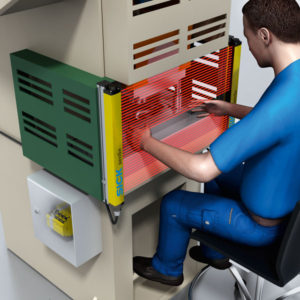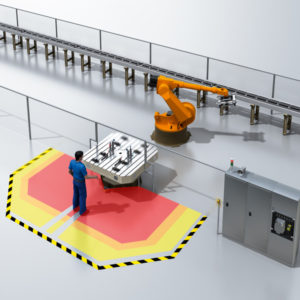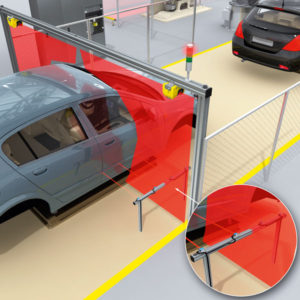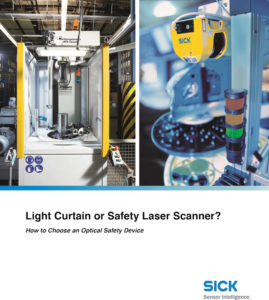From machine building to parts manufacturing to mobile robotics, safeguarding machinery is a critical step to ensuring the smooth operation of any manufacturing facility. Safety light curtains and safety laser scanners are two of the most common safeguarding technologies, and both optical safety technologies can be used for many safety applications including point-of-operation guarding, area guarding and perimeter protection, and entry/exit.
But how do you choose the right technology for your application? While we strongly recommend consulting a safety professional about your specific application requirements, we’ve compiled some general considerations that can help you identify an appropriate safety technology.
Point of Operation
The point of operation refers to the area of the machine where work is performed. In protecting points of operation, approach is detected within a very close proximity to the hazardous point. The advantage of using an optical device for point-of-operation protection is that it allows for a short minimum distance, and the operator can work more ergonomically (for example, during loading work on a press).
How does a light curtain solve this?
With a safety light curtain, the sender unit emits pulses of infrared light beams to a receiver unit. The light curtain can then detect interruptions to one or more light beams within the sensing field. Safety light curtains like SICK’s deTec4 family are ideal for point-of-operation protection due to their slim profile that can easily be mounted close to the hazard and their small resolution between beams. For example, the resolution can be set small enough to detect a hand or even one finger. This allows the safety system to respond quickly when the sensor is tripped.
How does a safety laser scanner solve this?
A safety laser scanner most likely would not be used for this type of application, since laser scanners generally require a greater minimum distance from the hazard due to the longer response time of the device. Instead, another option for point-of-operation guarding would be a safety-rated Vision System, like SICK’s V300.
Important considerations
When choosing a safety technology, you must always consider the minimum safety distance calculation. This is especially important for point-of-operation applications because people are working so close to the hazard that you must ensure that the machine can be stopped before injury occurs. For a detailed explanation of this calculation, read our previous post: How to Determine the Minimum Safety Distance.
It is also important to consider the size and discreteness of the optical safety device. The device should be able to protect a worker from injury while also maintaining an ergonomic workspace.
Area Protection / Perimeter Guarding
In the case of hazard area protection, the approach of the person is detected by sensing the person’s presence in an area. Area protection is necessary for machines whose hazard area cannot be viewed completely from the position of the reset device. If the hazard area is entered, a stop signal is initiated—stopping the machine and preventing restart. Hazard area protection is also important for AGVs (automated guided vehicle), and cranes and stackers in order to protect people while the vehicles are in motion or docking to a fixed station.
 While area guarding and perimeter protection are similar (and sometimes used interchangeably), there are some differences that can help determine an appropriate optical safety device. Area guarding generally refers to safeguarding a hazard point on a single side of the machine, especially when there is close interaction with the machine—for example, a robot cell or a tube bending machine. Perimeter guarding refers to safety measures that protect multiple sides of the machine. Typically, we see safety laser scanners used more in area protection, and safety light curtains used more in perimeter guarding applications.
While area guarding and perimeter protection are similar (and sometimes used interchangeably), there are some differences that can help determine an appropriate optical safety device. Area guarding generally refers to safeguarding a hazard point on a single side of the machine, especially when there is close interaction with the machine—for example, a robot cell or a tube bending machine. Perimeter guarding refers to safety measures that protect multiple sides of the machine. Typically, we see safety laser scanners used more in area protection, and safety light curtains used more in perimeter guarding applications.
How does a light curtain solve this?
Since the light curtain uses the sender/receiver concept, it can easily be used in conjunction with mirrors to guard multiple sides of a machine. Depending on the setup, you could also potentially mount light curtains very close to the machine, saving valuable floor space.
How does a safety laser scanner solve this?
Because the safety laser scanner is based on freely defined fields, it may be able to be tucked into the machine for discrete mounting. Additional benefits of a safety laser scanner include the ability to switch between zones and the ability to segment field types for different outputs (for example, safety (protective) field or warning field).
Important considerations
As with all safety applications, minimum safety distance calculation is an essential step. In addition, for both area and perimeter guarding, it is important to consider whether optical guarding or hard-guarding (completely preventing access to the area) is the most appropriate safety measure.
You should weigh the benefits of fenceless safety, while also taking into account foot and AGV traffic in the area. For example, in some factory floor configurations with high traffic and narrow separation between guarding areas, hard-guarding may be more ideal to prevent frequently tripping the optical safety devices and causing the machines to come to a stop.
Entry / Exit
How does a light curtain solve entry/exit?
 Traditionally, if there aren’t access points covered by doors or hard guarding, muting has been used. Muting is a function used to temporarily deactivate the protective function of a protective device. This can be done using two- or four-muting sensors, such as inductive sensors or photoelectric sensors, which are logically evaluated to determine the sequence of the object moving through. If the sequence is correct, and all other parameters within the logic are met, the object will be allowed through the safety light curtain without stopping the work routine.
Traditionally, if there aren’t access points covered by doors or hard guarding, muting has been used. Muting is a function used to temporarily deactivate the protective function of a protective device. This can be done using two- or four-muting sensors, such as inductive sensors or photoelectric sensors, which are logically evaluated to determine the sequence of the object moving through. If the sequence is correct, and all other parameters within the logic are met, the object will be allowed through the safety light curtain without stopping the work routine.
Another way of moving material into a safeguarded area with a light curtain is active differentiation between person and machine (entry/exit function). For this application, horizontally arranged safety light curtains (AOPDs) are applied. The possibility of evaluating each light beam individually is used to differentiate the interruption pattern of the material or material carrier (e.g., pallet) from a person. This differs from muting, because muting sensors are not required, so there are less mechanical mounting efforts and less wiring needed.
By using self-teaching dynamic blanking, as well as other differentiation criteria such as direction of movement, speed, entry and exit in the protective field, etc., a safety-relevant distinction can be made. In this way, undetected entry into the hazard zone can be reliably prevented (see right image).
How does a safety laser scanner solve entry / exit?
 Active switching of protective fields provides another way of moving material into a safeguarded area. For this application, safety laser scanners are normally used with vertical (or slightly tilted) protective fields.
Active switching of protective fields provides another way of moving material into a safeguarded area. For this application, safety laser scanners are normally used with vertical (or slightly tilted) protective fields.
The appropriate protective field, from a series of preprogrammed protective fields, is activated by corresponding signals from the machine controller and adequately positioned sensors.
The contour of the protective field is designed so that passage of the material does not cause the protective device to activate and any unmonitored areas are small enough to prevent undetected access to the hazard zone (see left image).
Important Considerations
We most often see safety light curtains in entry/exit applications because it is an effective and economical solution in most cases; however, there are certain instances where you might want to use a laser scanner instead. For example, if you do not have an appropriate space to mount two perpendicular devices, a laser scanner would be the more feasible choice.
This blog post is meant as a guideline only and is accurate as of the time of publication. When implementing any safety measures, we recommend consulting with a safety professional.






